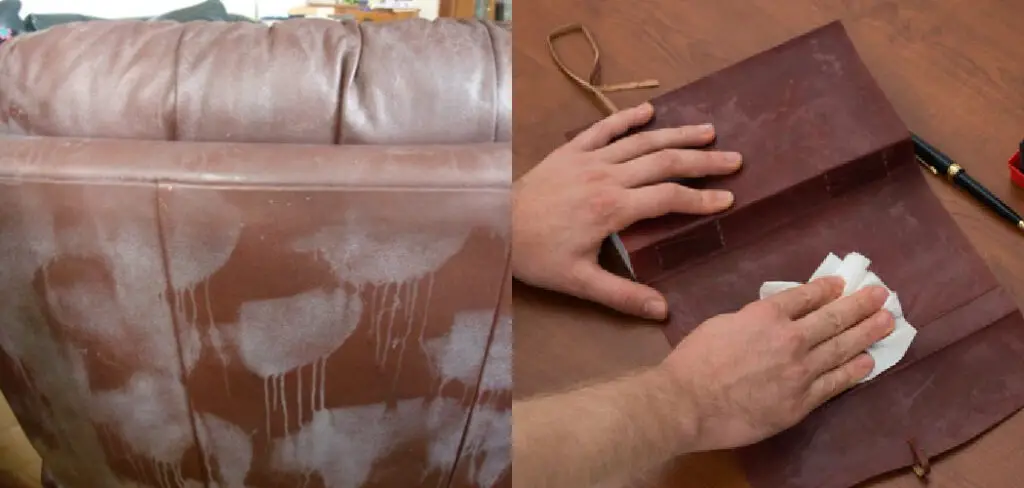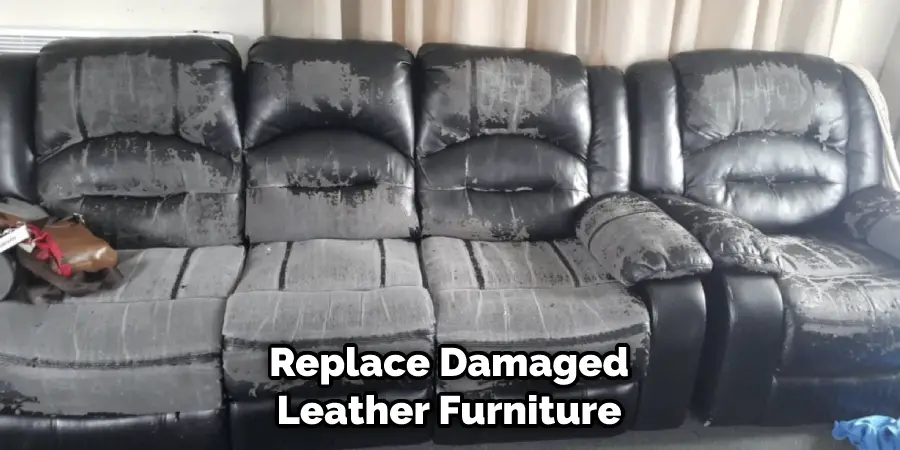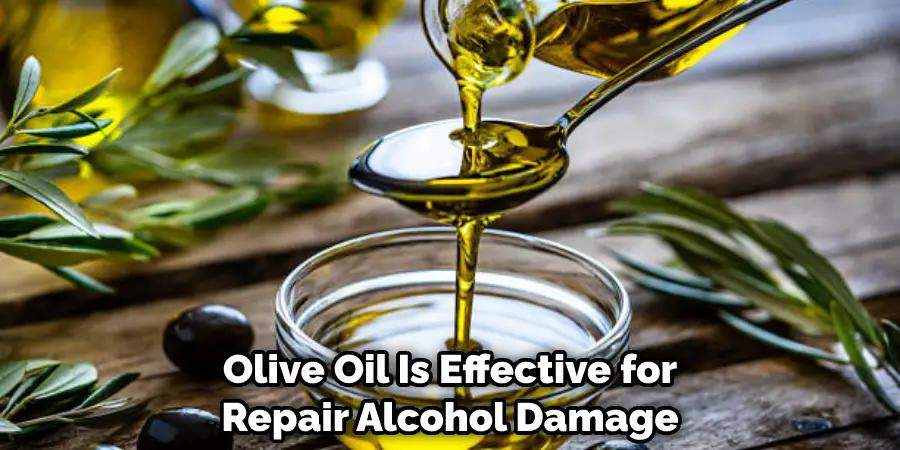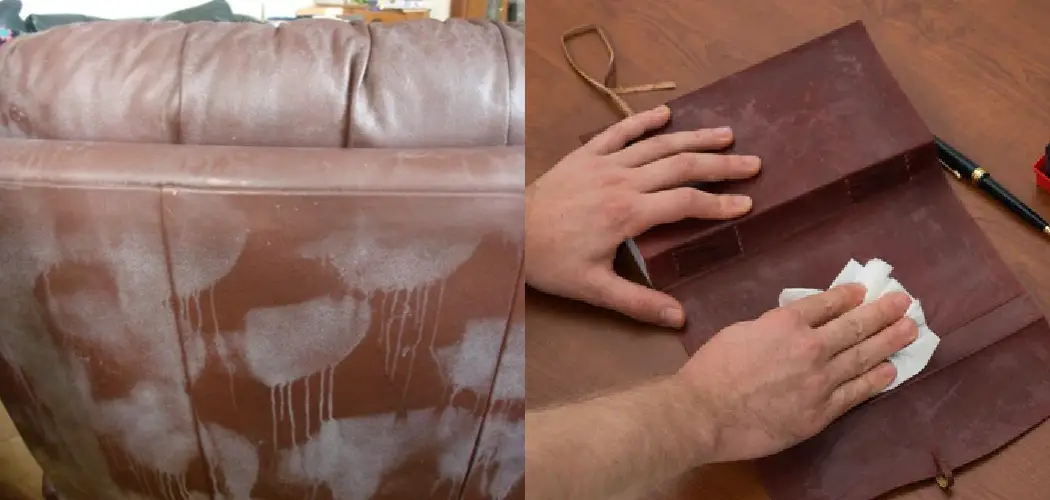Although leather is a durable and resilient material, it can still be susceptible to damage from alcohol. If you’ve spilled whiskey or another alcoholic drink on your leather couch or chair, don’t worry – there are ways to repair the damage. This blog post will show you how to repair alcohol damage on leather using simple steps and supplies. Let’s get started!

What Causes Alcohol Damage to Leather?
Various factors can cause alcohol damage to the leather. One of the most common is spills. When an alcoholic beverage is spilled on leather, it can penetrate the surface and cause the leather to dry out. This can lead to cracking, peeling, and other forms of damage.
Another common cause of alcohol damage to leather is improper cleaning. Using a cleaning product containing alcohol can strip away the natural oils from the leather, causing it to dry out and crack. Additionally, using rubbing alcohol to clean leather can also cause damage.
The other main cause of alcohol damage to leather is exposure to sunlight. The UV rays from the sun can cause the leather to fade and crack over time. Lastly, extreme heat or cold can also cause damage to the leather.
Why Is It Important to Repair Alcohol Damage?
It’s important to repair alcohol damage to leather because it can cause the material to deteriorate quickly. Once the leather starts to crack and peel, it will become more susceptible to further damage.
Additionally, damaged leather can be unsightly and affect the overall aesthetic of your space. Another reason to repair alcohol damage is that it can be expensive to replace damaged leather furniture. By repairing the damage, you’ll save money in the long run.

If you have damaged leather furniture, it’s important to take action as soon as possible to prevent further damage. Finally, repairing alcohol damage to leather can also help extend your furniture’s life.
Some Easy Ways How to Repair Alcohol Damage on Leather
1. Use a Leather Repair Kit
If you want to repair alcohol damage to leather, one of the best things you can do is invest in a leather repair kit. These kits contain everything you need to fix minor, including alcohol damage. They typically include a leather cleaner, repair compound, colorant, and instructions.
First, use a leather repair kit to clean the area with the leather cleaner. Then, apply the repair compound to the damaged area. Once it’s dry, apply the colorant to match the surrounding leather. You can also purchase these items separately if you don’t have a leather repair kit.
2. Use Soap and Water
If you don’t have a leather repair kit, you can still repair alcohol damage to leather using soap and water. First, mix a small amount of dish soap with warm water. Then, use a soft cloth to clean the damaged area. Be sure to rinse off the soap and water completely. Once the area is dry, apply a leather conditioner to help restore moisture. This method is best for small areas of damage.
3. Apply Olive Oil
Olive oil is another effective way to repair alcohol damage to the leather. This method is best for small areas of damage. First, clean the area with a mild soap and water solution. Then, dry it off completely. Next, apply a small amount of olive oil to a clean, soft cloth.

Rub the cloth onto the affected area in a circular motion. Allow the olive oil to soak into the leather for about 15 minutes. Finally, wipe off any excess oil with a clean, dry cloth. If the damage is severe, you may need to repeat this process several times. Avoid using too much olive oil, as it can cause the leather to become sticky.
4. Apply Leather Conditioner
A leather conditioner can help repair alcohol damage by restoring moisture to the leather. This will help to keep the leather from drying out and cracking. Be sure to test the conditioner on a small leather area first to ensure it does not cause further damage. First, clean the leather with a leather cleaner.
Then, apply the conditioner with a soft cloth and buff it to the leather. Allow the conditioner to soak in for a few minutes before wiping off any excess. Repeat this process as needed to repair alcohol damage on leather. Avoid using a conditioner too often, as this can cause the leather to become greasy.
5. Use a Boiled Egg
A boiled egg can help to repair alcohol damage on leather by replenishing the natural oils. This is because the egg yolk contains a high amount of lecithin, the natural fat that helps lubricate and protect the leather. First, remove the eggshell and then rub the yolk onto the affected area.

Allow it to sit for at least 15 minutes before wiping it off with a clean cloth. You can do this once a day until the damage is repaired. If you have any leftover egg whites, you can also use them to clean the leather.
Apply the egg white to a soft cloth and rub it onto the leather in a circular motion. Allow it to dry, and then buff it with a clean cloth. Avoid using too much egg white, as it can cause the leather to become sticky.
6. Use Vinegar
Vinegar is another effective way to repair alcohol damage on leather. This method is best for small areas of damage. First, clean the area with a leather cleaner. Then, apply a small amount of vinegar to a clean cloth and rub it into the affected area. Allow the vinegar to dry, then buff the area with a clean cloth.
If the area is still discolored, repeat the process. You can also use vinegar to remove water stains from leather. Apply a small amount of vinegar to a clean cloth and rub it into the stain. Allow the vinegar to dry, then buff the area with a clean cloth.
7. Use a Hairdryer
A hairdryer can help to repair alcohol damage on leather by restoring the natural oils. This will help to soften the leather and make it more pliable. First, clean the area with a damp cloth. Then, using a low setting, hold the hairdryer about six inches from the leather and move it around in a circular motion.
Do this for several minutes, then allow the leather to dry completely. You can also use a vacuum cleaner with a soft brush attachment to help remove any debris from the surface of the leather. If the leather is still stiff, you can repeat this process.
8. Use Saddle Soap
Saddle soap is a type of soap that is specifically designed for cleaning and conditioning leather. It can be found at most stores that sell equestrian supplies or online. Saddle soap will clean the leather and help to repair any damage that the alcohol has caused. Wet a cloth with warm water to use saddle soap and then add a small amount of saddle soap.

Rub the cloth over the affected area in a circular motion. Rinse the area with warm water and then dry it off with a clean cloth. Repeat this process until the alcohol damage has been repaired. If the leather is very badly damaged, you may need to use a leather conditioner after the saddle soap to help restore it.
You Can Check It Out to Repair Leather Headboard
9. Apply Vaseline
Applying a small amount of Vaseline can help to repair alcohol damage on leather. This is because Vaseline contains petroleum jelly, which will help to moisturize the leather and make it more supple. To use this method, first clean the leather with a damp cloth.
Then, apply a small amount of Vaseline to a cotton ball and rub it into the leather in a circular motion. Allow the Vaseline to soak into the leather for at least 15 minutes before wiping it off with a dry cloth. If the leather is still feeling dry or stiff, repeat this process until the leather is soft and supple again.
10. Hire a Professional
If the alcohol damage on your leather is extensive, you may need to hire a professional to repair it. A professional will have the tools and experience necessary to repair the damage without causing any further damage to the leather.
If you have a piece of furniture made of leather, such as a sofa or chair, you should contact a professional upholsterer to repair the damage. If you have a leather garment, such as a coat or jacket, you should take it to a dry cleaner or leather repair shop to have the damage repaired.
You Can Check It Out to Restore Worn Leather Couch
How Much Does It Cost to Repair Alcohol Damage on Leather?
The cost of repairing alcohol damage on leather will depend on the extent of the damage and the type of leather. If the damage is extensive, you may need to hire a professional to repair it, which can cost upwards of $100.
For smaller areas of damage, you can purchase a leather repair kit, which will cost between $10 and $30. For very small areas of damage, you can use a home remedy, such as vinegar or saddle soap, which will cost less than $5.
Frequently Asked Questions
Can Alcohol Ruin Leather?
Alcohol can ruin leather, but it depends on the type of alcohol and the severity of the damage. In general, ethyl alcohol (the type most commonly found in liquor) is the most damaging to leather because it breaks down the skin and fiber structure of the leather. However, other types of alcohol (like vodka) can also damage leather if used excessively. In general, alcohol should only be used as a final step after other treatments (like a conditioning cream) have failed to restore the leather to its original condition.
Is Vaseline Good for Leather?
The effects of Vaseline on leather may vary depending on the severity of the condition, the type of leather, and the application method. Some users may report that Vaseline can help to soften and protect leather from dryness and cracking, while others may say that it has no effect at all. Ultimately, it is best to test Vaseline on a small section of your leather to see if it has any positive effects and then proceed with caution – overuse or incorrect application could lead to damage or even loss of leather.
Are Alcohol Stains Permanent?
The effects of alcohol on clothing and fabric vary depending on the type and amount of alcohol involved, the severity of the stain, and the care and laundering procedures used. In general, however, alcohol stains are likely to remain visible and difficult to remove even after extensive treatment with household detergents and bleaches. Alcohol-based stains can be difficult to remove completely, but they can usually be reduced in severity by cleaning the area thoroughly with a diluted solution of soap and water, followed by a thorough rinse. If the stain is still present after these initial steps have been taken, it may be necessary to use a stronger detergent or cleaner in order to completely remove it.
Which Oil is Best for Leather?
Oil choice will depend on the type of leather, the severity of the condition, and the individual preferences of the painter. However, some popular oils that are often used on leather include mineral oil, lanolin oil, petrolatum, and linseed oil. Mineral oil is a lightweight oil that is easy to work with and has a low odor. Lanolin oil is a thick, oily substance that is commonly used in cosmetics and veterinary medicine. Petrolatum is a soft, white petroleum jelly that is often used as an lubricant or as a coating for paints and other materials. Linseed oil is a heavy oil that can be used on all types of leathers and is especially effective at breaking down stains and restoring fading colors.
Conclusion
So there you have it! Now you know how to repair alcohol damage on leather. Be sure to follow these tips so that you can get your leather looking like new again. Do you have any tips on how to repair alcohol damage on leather? If so, please share them in the comments below. Thanks for reading!

